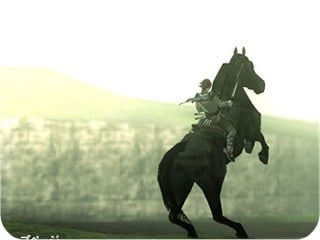Game reviewers sometimes put a little too much stock into their own opinions. We can’t believe consumers would buy a game that we said was garbage and we also can’t believe it when people don’t buy games that we rave about. Case in point: Ico.
Ico was released in September 2001 to a rabid collection of hardcore gamers who had been waiting with baited breath to get their hands on this incredibly innovative and visually stunning PS2 title. Unfortunately, it was a very small collection of hardcore gamers. Reviewers and word of mouth was almost exclusively positive and yet, sales were much lower than expected. Game journalists were flabbergasted. Could it be that the average person didn’t give a shit about what we had to say? Yup. The average Wal-Mart zombie wasn’t interested in researching what was good and what was to be avoided, they just liked the pretty box art or spent their hard earned money on games that featured Saturday morning cartoon icons. So Ico tanked and that was that.
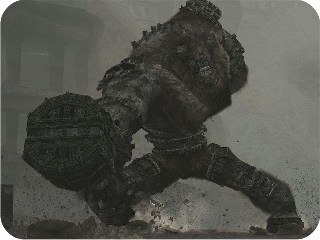 Talk of a sequel to Ico emerged a few months after the title was released, but it appeared that Sony had more than likely greenlighted development on a followup while the first was still in production, based entirely on expectations of the first game. With hopes dashed of cashing in on Ico, Sony appeared to abandon the project.
Talk of a sequel to Ico emerged a few months after the title was released, but it appeared that Sony had more than likely greenlighted development on a followup while the first was still in production, based entirely on expectations of the first game. With hopes dashed of cashing in on Ico, Sony appeared to abandon the project.
Here we are almost 4 years later and Sony is ready to try again. Fresh from the success of the incredible God of War, Sony looks to be ready to kick the ass of popular opinion and give fans a sequel – a sequel to a game that nobody played. We love that rebel spirit around here and just like those early months in 2001, we can’t wait to play it.
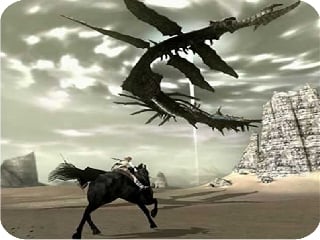 Entitled Shadow of the Colossus, the game seems to be a spiritual successor to the first game as aside from a brief appearance of the protagonist wearing a horned helmet ala Ico, this game is dealing with new characters. One of those characters is the dude on the horse, who currently is unnamed. The entire purpose of the game revolves around this unconscious female the hero must take to a temple at the World’s End to save her soul. The only way for our hero to save her, is by kicking the ass of the Colossi that inhabit this world and that doesn’t appear to be all that easy judging by the size of those suckers. They’re freakin’ huge!
Entitled Shadow of the Colossus, the game seems to be a spiritual successor to the first game as aside from a brief appearance of the protagonist wearing a horned helmet ala Ico, this game is dealing with new characters. One of those characters is the dude on the horse, who currently is unnamed. The entire purpose of the game revolves around this unconscious female the hero must take to a temple at the World’s End to save her soul. The only way for our hero to save her, is by kicking the ass of the Colossi that inhabit this world and that doesn’t appear to be all that easy judging by the size of those suckers. They’re freakin’ huge!
Because game reviewers aren’t very smart, we like to pigeonhole everything into bits of info we can understand, therefore we’re thinking Sony could be going for something along the lines of Legend Of Zelda errr….Wanda. There appears to be lots of horseback ridiing and adventuring. Needless to say, appetites are whetted and we aren’t even sure if that’s correct grammar and we don’t really care.
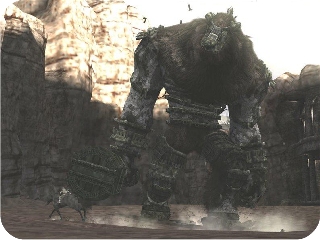 While Ico was a puzzle game wrapped in an adventure setting, Wanda appears to focus more on battle, perhaps a sore area that Sony is smarting from when it wonders where it went wrong with the first game. From the screens we’ve nabbed it appears that fighting the Colossus is unavoidable; we just don’t know if Wanda and the giant will remain at odds throughout the entire game. Also the trailer shows the hero jumping onto the giant as well as flying serpentlike monster and attacking head on. Very nice. The platforming aspects of the game will involve moving around on these giants and trying to destroy them. The horse, we’re told, will be an AI partner, there to provide locomotion and not something you’ll have to protect, like Yorda (the female) in Ico.
While Ico was a puzzle game wrapped in an adventure setting, Wanda appears to focus more on battle, perhaps a sore area that Sony is smarting from when it wonders where it went wrong with the first game. From the screens we’ve nabbed it appears that fighting the Colossus is unavoidable; we just don’t know if Wanda and the giant will remain at odds throughout the entire game. Also the trailer shows the hero jumping onto the giant as well as flying serpentlike monster and attacking head on. Very nice. The platforming aspects of the game will involve moving around on these giants and trying to destroy them. The horse, we’re told, will be an AI partner, there to provide locomotion and not something you’ll have to protect, like Yorda (the female) in Ico.
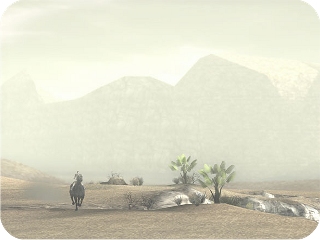 Visually the game looks to be pushing the PS2 to its absolute limits and in doing so will make many wonder why the PS3 is so close to being released when Wanda is finally released later this Fall. Who needs a new system when the old one is capable of such beauty? Check out the screens for yourself. There is magic at work here.
Visually the game looks to be pushing the PS2 to its absolute limits and in doing so will make many wonder why the PS3 is so close to being released when Wanda is finally released later this Fall. Who needs a new system when the old one is capable of such beauty? Check out the screens for yourself. There is magic at work here.
We don’t know anything at all about the game and at this point, Sony is mum on the subject, not wanting to tilt their hand until E3 next month. We’ll be there and waiting for any morsels so stay tuned.
